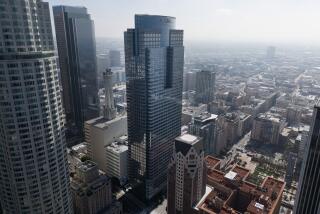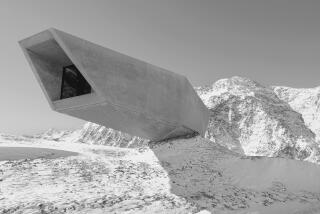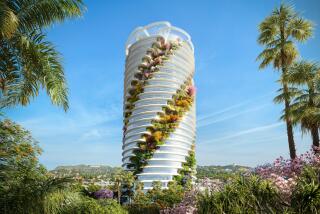Critic’s notebook: Skyscrapers remain powerful symbols, post 9/11
- Share via
Any skyscraper is a contradiction.
The tall tower is architecture’s most famous building type and also the one most clearly at odds with the profession’s roots. Fundamentally, architecture is shelter, a concession that we’re afraid to face the elements without protection. A skyscraper is vertical hubris.
Perhaps no architect embodied the oddness of skyscraper architecture more than Minoru Yamasaki, the Seattle native who designed the 110-story World Trade Center towers. Yamasaki was afraid of heights; he made the windows of the twin towers just 18 inches wide to ease the fears of the people inside the buildings who shared his anxiety.
“If I had no economic or social limitations,” he once said, “I’d solve all my problems with one-story buildings. Imagine how pleasant it would be to always work [in] spaces overlooking lovely gardens filled with flowers.”
Even Yamasaki, who died in 1986, might be surprised by the latest wrinkle in the skyscraper story: The decade since the 2001 destruction of the twin towers, an attack that some predicted would spell the end of the tall building, have turned out to be the busiest ever for skyscraper design.
More skyscrapers have gone up in the last 10 years than in all of architectural history before the destruction of the World Trade Center — and by a significant margin. More than 350 towers measuring at least 200 meters, or 663 feet, have been constructed since the end of 2001, according to the Chicago-based Council on Tall Buildings and Urban Habitat. Just 235 buildings that high went up in the years before 2001.
The last decade has been particularly productive for designers of so-called supertall towers, those at least 1,250 feet high — the height of the Empire State Building. According to “Supertall!,” an exhibition running through January at the Skyscraper Museum in New York, 48 such mega-towers have been completed since 2001 or are in the works. A star of the exhibition is the Burj Khalifa, which opened early last year in Dubai as the tallest building in the world. Designed by the Chicago architect Adrian Smith, it rises a staggering 2,717 feet, or higher than the twin towers stacked one atop the other.
In large part the explanation for this wave of towers is economic. The global economy was booming by the middle of the last decade, and the biggest nations in the world have been urbanizing at an unprecedented clip. (China alone has built about half of the post-9/11 towers.) In the West, easy credit in those years helped finance scores of new skyscrapers, many filled with condominiums that their owners are still struggling to sell. Surging oil wealth has gilded skylines not just in Dubai and Abu Dhabi but in Moscow and Astana, the capital of Kazakhstan.
The crop of supertall towers also has advances in engineering and technology to thank. It is easier than ever to predict how tall buildings will react to earthquakes and high winds. But there is also a political and psychological dimension to any supertall tower. Quickly growing or modernizing countries still see the skyscraper — as Americans did in the 20th century — as the ultimate prestige project.
There may be lingering post-9/11 skittishness in this country about living or working 100 stories above the ground. But our nervousness is increasingly irrelevant to global skyscraper statistics. In 2010, the tallest building constructed in the United States — the 818-foot-tall, 72-story Legacy Tower in Chicago — was the 19th tallest in the world. It was outranked by towers in Dubai, Abu Dhabi, Hong Kong, Nanjing, Shanghai, Ho Chi Minh City and Istanbul, among other cities.
In purely architectural terms, the most important building to go up since the 9/11 attacks is the CCTV Tower in Beijing by Rem Koolhaas and Ole Scheeren of the Office for Metropolitan Architecture. It is a skyscraper, though at 768 feet not an especially tall one. But that relative shortness is part of the tower’s strategic allure: It rejects the arm’s race for architectural height — which, as Koolhaas has pointed out, is always a losing proposition, since somebody is always planning a building taller than yours — in favor of a design whose Mobius-strip strangeness makes it uniquely powerful in person.
The building is the most unmistakable representation of state power and government indifference that I’ve ever seen. If you want to feel really small — really ant-like — don’t go stand in front of the Chrysler Building or the Park Fifth Tower in downtown L.A. Stand in front of CCTV.
Anyone who spends a lot of time thinking about skyscrapers begins to expect twists and turns, switchbacks and ironies. Here is the latest one: Saudi Arabia, home to 15 of the 19 Sept. 11 hijackers, announced plans this summer to erect a building in Jeddah, Saudi Arabia’s second-largest city, that will be more than 500 feet taller than the Burj Khalifa. Designed by Smith and his partner Gordon Gill, the Kingdom Tower will be at least a kilometer — or 3,280 feet — tall.
In Saudi Arabia, Dubai and other wealthy, quickly expanding places, the skyscraper has been freed from two of its classic constraints. The first is Manhattanism — that tall towers were historically built in dense downtown districts and hemmed in by the urban grid and setback requirements. The second is the business suit — that the skyscraper was, by definition, an office building.
The Kingdom Tower will rise from the middle of a brand-new, $20-billion mixed-use development laid out by the American firm HOK Architects. Its first few floors will hold offices, but after that it will be filled with a Four Seasons hotel and dozens upon dozens of residential floors. The tower’s most noticeable formal flourish is a terrace jutting out from the 157th floor; it is not an observatory for the public but a private outdoor space for the skyscraper’s penthouse — a front yard more than 3,000 feet in the air.
Smith told me by phone that the tower’s site is not far from one of Saudi Arabia’s best-known postwar buildings, Skidmore, Owings and Merrill’s 1981 Hajj Terminal. Other than that, he added, the area “is pretty much a desert.”
That may help explain the resemblance between the Kingdom Tower and the Illinois, a slender mile-high tower that Frank Lloyd Wright proposed in 1956 for a site in Chicago. (That tower, never built, also seemed to rise from the middle of nowhere.) The Kingdom Tower site, in fact, was originally slotted to hold its own mile-high tower, designed by architecture firm Pickard Chilton. That project was shelved in early 2009 after the global financial crisis hit.
In this country too, most of the architecturally compelling towers of the last decade have been designed to hold bedrooms rather than corner offices. Frank Gehry’s new skyscraper in Lower Manhattan wraps 903 apartments inside an undulating, crumpled stainless-steel skin that recalls the work of architects as diverse as Bernini and Cass Gilbert.
In Chicago, Santiago Calatrava proposed a torquing, screw-like condo tower for the Chicago lakefront that at exactly 2,000 feet would have been the tallest building in North America. Sadly, it was a victim of the credit crunch. So was a stunning, ultra-thin glass tower, to be draped with hanging gardens, that French architect Jean Nouvel proposed for Century City.
Back in New York, the skyscraper continues to argue with itself. Immediately north of the site where the twin towers once stood are two new skyscrapers. One, called 7 World Trade Center, was completed five years ago, covering 52 stories. The other, 1 World Trade Center — originally called the Freedom Tower — is under construction. When finished it’ll reach a height of 1,776 feet, at least if you count its needle-like spire, and rank as the tallest building in the United States.
Both towers are the work of Skidmore, Owings and Merrill, though 1 World Trade began as a testy collaboration between Skidmore’s David Childs and Daniel Libeskind, the master planner for the World Trade Center site. But the buildings could hardly be more different architecturally.
The design for 1 World Trade Center is stolid and inexpressive. The quietly precise, blade-like 7 World Trade, thanks in part to a happier partnership between Childs and the glass artist James Carpenter, is among the most graceful towers to go up in an American city in two decades.
So is the skyscraper a dead end for architectural creativity or a wellspring of ingenuity? Is it a symbol of unfettered market economics or political muscle? A soaring beacon or a stack of anxieties? The answer in each case is that it is both. Always both.
More to Read
The biggest entertainment stories
Get our big stories about Hollywood, film, television, music, arts, culture and more right in your inbox as soon as they publish.
You may occasionally receive promotional content from the Los Angeles Times.











